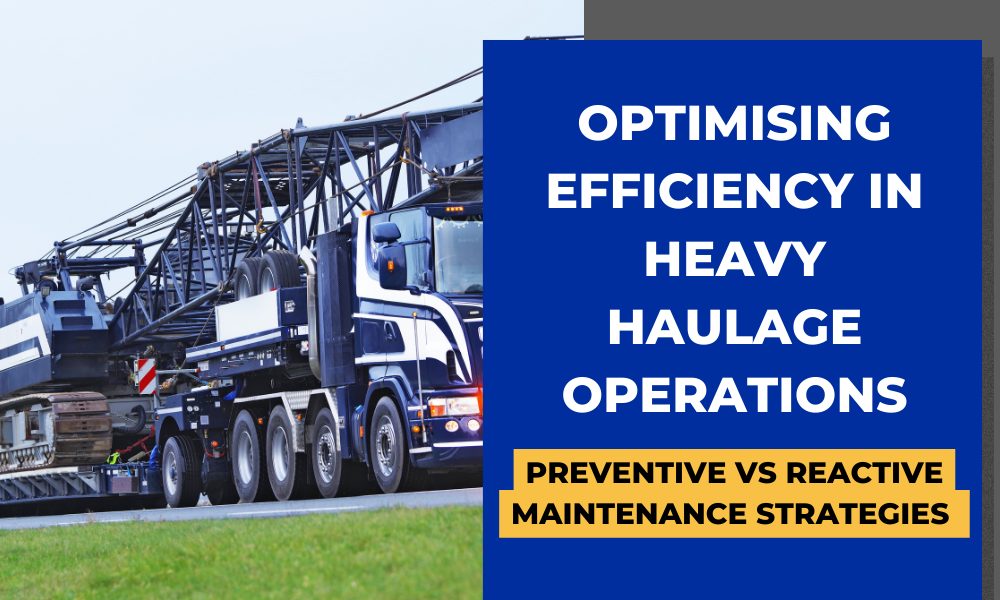Within heavy haulage operations, where time equates to money and efficiency stands as paramount, the decision between preventive and reactive maintenance holds profound significance. Serving as the backbone of the transportation industry, heavy haulage firms depend on their fleet to deliver goods securely and punctually. Nevertheless, unforeseen breakdowns and equipment malfunctions can lead to costly downtime, imperilling deadlines.
At WA Haulage Repairs, we’ve seen how preventative and reactive maintenance approaches can affect the efficiency of a haulage fleet. That’s why we’ve put this article together to demonstrate the critical importance of effective maintenance strategies.
Understanding Preventive Maintenance
Preventive maintenance entails scheduled inspections, servicing, and repairs aimed at forestalling breakdowns and extending the lifespan of equipment. Rather than waiting for components to fail, preventive maintenance adopts a proactive stance, addressing potential issues before they burgeon.
In the context of heavy haulage operations, this involves conducting routine checks on vehicles, trailers, and associated machinery to ensure they remain in optimal working order.
The Benefits of Preventive Maintenance
Preventative maintenance can provide your business with many benefits including:
- Enhanced Equipment Reliability: By identifying and rectifying minor issues at an early stage, preventive maintenance helps to uphold the reliability of equipment, thereby reducing the likelihood of unexpected breakdowns and ensuring smoother operations.
- Reduced Downtime: Scheduled maintenance enables companies to tackle issues during planned downtime, minimising the impact on productivity. This proactive approach aids in keeping vehicles on the road and deliveries on schedule.
- Extended Equipment Lifespan: Regular servicing and upkeep can significantly prolong the lifespan of heavy haulage equipment, mitigating the need for premature replacements and yielding long-term cost savings.
- Improved Safety: Regular inspections guarantee that vehicles meet safety standards, diminishing the risk of accidents and injuries on the road.
Implementing Reactive Maintenance
Conversely, reactive maintenance involves addressing issues solely when they arise. Instead of adhering to a predetermined schedule, repairs are carried out in response to equipment failures or malfunctions. Although reactive maintenance may appear cost-effective initially, it can lead to higher expenses and increased downtime over time.
The Drawbacks of Reactive Maintenance
Reactive maintenance can be a disadvantage for your business especially with:
Higher Costs: Reactive maintenance often necessitates emergency repairs, which can be more costly than planned servicing. In addition to the expense of parts and labour, companies may also incur supplementary costs such as towing fees and lost revenue due to downtime.
Unpredictable Downtime: Equipment failures can transpire at any moment, disrupting operations and causing delays in deliveries. This unpredictability renders it challenging to plan and coordinate logistics effectively.
Increased Risk of Damage: Neglecting routine maintenance elevates the risk of equipment damage and wear. Over time, this can lead to more frequent breakdowns and costly repairs.
Choosing the Right Strategy
When deliberating heavy haulage operations, the choice between preventive and reactive maintenance hinges on several factors, encompassing fleet size, operational requirements, and budget constraints. While reactive maintenance may present a quick-fix solution, investing in preventive maintenance can yield long-term benefits and ensure smoother operations.
Tips for Effective Fleet Maintenance:
1. Develop a Maintenance Schedule: Formulate a comprehensive maintenance schedule encompassing routine inspections, servicing, and repairs. This will facilitate the early identification of potential issues and preclude unexpected breakdowns.
2. Invest in Training: Ensure that maintenance personnel receive adequate training to conduct inspections and repairs proficiently. Proper training can enhance efficiency and diminish the likelihood of errors.
3. Utilise Technology: Leverage technology such as fleet management software and diagnostic tools to streamline maintenance processes and monitor equipment health in real-time.
4. Track Performance Metrics: Monitor key performance metrics, including equipment uptime, maintenance costs, and fuel efficiency, to pinpoint areas for improvement and optimise maintenance schedules.
Invest in Preventive Maintenance with WA Haulage Repairs
By prioritising preventive maintenance and embracing proactive strategies, heavy haulage companies can minimise downtime, enhance equipment reliability, and ultimately, improve their bottom line. While reactive maintenance may offer a transient solution, it is preventive maintenance that underpins long-term success in the competitive realm of heavy haulage operations.
Ready to revolutionise your heavy haulage operations? Contact the expert team at WA Haulage Repairs today on (08) 9359 0422 to chat about tailoring a preventive maintenance plan to suit your needs and propel your business towards long-term success.

